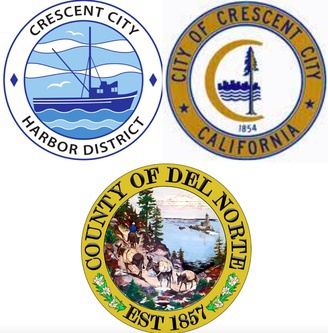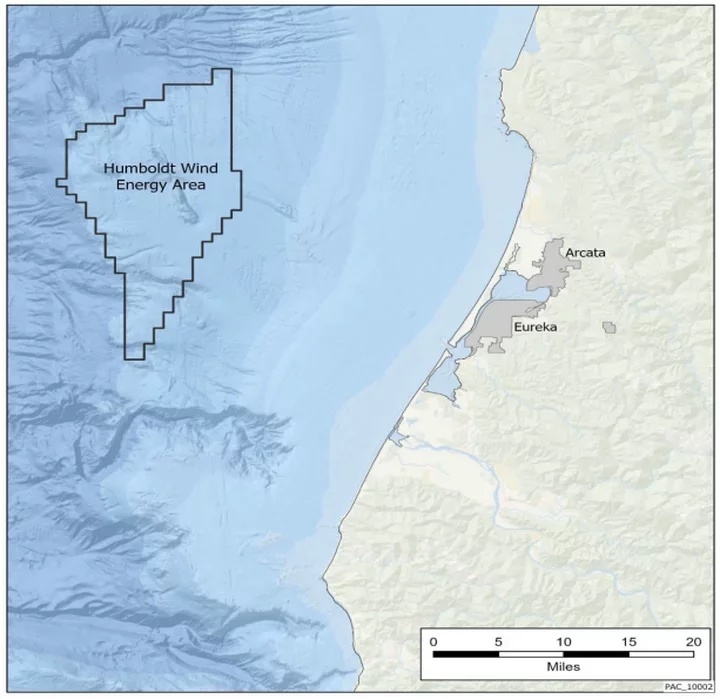Jessica Cejnar Andrews / Friday, May 26, 2023 @ 3:30 p.m. / Community, Infrastructure, Local Government, Ocean
A Rebooted Tri-Agency Seeks to Reclaim Its Economic Driver Role in Del Norte, Looks to Facilitate Conversation About OffShore Wind Energy

The Tri-Agency Economic Authority consists of representatives from Crescent City, Del Norte County and the Crescent City Harbor District.
One prominent member of a local joint-powers authority trying to reboot itself reiterated that its days of being a lender of last resort are over.
The Tri-Agency Economic Development Authority repaid the balance of a U.S. Department of Agriculture loan in October. As it moves forward, the JPA hopes to expand to include the sovereign nations that call the county home, District 3 Supervisor Chris Howard said.
The Authority has also rewritten its bylaws, Howard said.
“Some loans were made and defaulted on by various individuals and the agency was left holding the bag with the USDA,” Howard told the Wild Rivers Outpost on Friday. “The agency’s very clear that they will not be a lender of last resort again. That is now language in our bylaws.”
Howard is one of two county supervisors on the Tri-Agency board. The other is District 5 Supervisor Dean Wilson. Jason Greenough and Blake Inscore represent Crescent City and Wes White and Brian Stone represent the Crescent City Harbor District.
Updating the Tri-Agency’s bylaws will be up for discussion at a joint meeting between the three governing bodies in July, said County Counsel Joel Campbell-Blair, who has been acting as staff liaison for the JPA. The three boards will also discuss whether the Tri-Agency should even continue, he said.
“Another topic at the joint meeting is if [the Authority] continues, what should the scope be?” Campbell-Blair said. “What should they be able to do and what shouldn’t they be able to do?”
The Tri-Agency Economic Development Authority was created to help Del Norte County’s economic recovery following the 1964 tsunami. The JPA brought two revolving loan programs to Del Norte County.
One was funded through the USDA and had been administered through Del Norte Economic Development Authority since 1976. The Tri-Agency hasn’t been fully responsible for that loan since 2018, Campbell-Blair told supervisors in January 2022.
The second loan was created in 1997 using $400,000 the Tri-Agency borrowed from USDA Rural Development. This is the loan the Tri-Agency defaulted on in 2011. In 2012, the USDA accelerated that debt, according to Campbell-Blair.
On Friday, Campbell-Blair told the Outpost that the Tri-Agency paid the balance of that loan, about $290,000, in October 2022. The JPA had about $130,000 in the bank at the time. The city and county each contributed $60,000 toward repaying that loan while the Crescent City Harbor District kicked in $40,000, Campbell-Blair said.
The USDA acknowledged receipt of that payment via email in January 2023, according to Campbell-Blair.

Del Norte officials are looking at how offshore wind energy development is unfolding in Humboldt Bay. | Map: BOEM
Now as the Tri-Agency seeks to reestablish its role as an economic driver in Del Norte, its members are looking to the development of offshore wind power and how it could impact the community, Howard said.
Both Del Norte County and the Tri-Agency have followed the progress of legislation designed to streamline the environmental permitting process, Howard said. This could impact the progress of several projects including green energy, housing and basic infrastructure like streets and roads, he said.
“We just want to make sure as an agency that we’re not only prepared to have a conversation with the community to hear their concerns,” Howard said, “we also want to make sure we are ready to benefit as a community from any opportunity that comes along and not sit on the sidelines.”
Last week Keith Taylor, a community economic development professor from U.C. Davis, who also works with the U.C. Cooperative Extension, gave a presentation on how Del Norte could make sure it benefits from offshore wind energy development.
Speaking at the Del Norte Economic Summit, Taylor introduced local business leaders to community benefit agreements as well as different wind farm models including electric co-ops and investor-owned endeavors.
Michelle Carrillo, the Humboldt Area Foundation and Wild Rivers Community Foundation’s vice president for strategy and community solutions, also introduced Del Norters to the Redwood CORE Hub, which brings academic, legal and policy experts as well as state, federal and tribal agencies together to understand “what’s coming and how we can navigate it.”
Carrillo said the Redwood CORE Hub’s focus is on Humboldt County since Humboldt Bay is one of two areas in California the U.S. Bureau of Ocean Energy Management (BOEM) has set aside for floating offshore wind development.
On Friday, Howard pointed out that Humboldt and Morro Bay — the second potential home for floating offshore wind platforms in California at this point — are about four years ahead of Del Norte County. And the Redwood CORE Hub has spearheaded much of the same community discussions the Tri-Agency seeks to spark locally.
“That is a natural model for us to follow and not reinvent,” he said. “Until the economic summit we weren’t even aware that the Humboldt Area Foundation was engaged in the wind conversation. It had not been communicated to us until then. So, we obviously as an agency in seeing the effectiveness of that model with engaging all the user groups and stakeholders, we obviously want to duplicate that. We do not want to reinvent the wheel.”
The Tri-Agency is also working with Alec Dompka, rural community and economic development advisor at the U.C. Cooperative Extension’s Del Norte office.
Dompka, who has been working in Del Norte County for about six months and has a background in agricultural economics, said he’s helping the Tri-Agency do research into the economic feasibility of wind farms for the local community.
“Are the increased costs of caring for workers or the increased use of our roads — are those costs made up for by the benefits of wind (power) and stuff like that,” he said as an example. “With the Tri-Agency I have no directional role. I support them with research and community outreach.”
That conversation is in its infancy partly because it’s not clear yet if Bureau of Ocean Energy Management will be offering any leases off the Del Norte County Coast, Dompka said. The scale of the wind farms is still up in the air as is where operations and maintenance will be based out of, he said.
Dompka pointed out that the platforms and wind turbines in Humboldt Bay may not be constructed until 2027 so it’ll be a long process.
Like Howard, Dompka said communicating with the Redwood CORE Hub will be important, especially once the wind farms begin to operate and the need for environmental monitoring as well as ensuring community benefit agreements are realized begins.
“Community benefit agreement negotiation has been probably one of my biggest focuses around energy and a lot of successful CBA agreements have monitoring clauses that requires a developer to monitor and publish their findings publicly,” he said. “A lot of my work is doing research on what community benefit agreements have been successful and how they organized them.”
According to Howard, there’s an advantage in this case of not being the first community in California to go through offshore wind energy development. Del Norte County can look at Humboldt and Morro Bay to see what’s worked for them and what they missed out on, he said.
“I really see the Tri-Agency’s job in this case as helping to determine how best to capture the benefit of an offshore wind site for the community,” Howard said, adding that reduced electricity rates may also be a possibility. “Our role when we go out and look at these community agreements that will be formed with the company, (that) is a negotiated process and we want to make sure we’re getting as much as we can.”
CLICK TO MANAGE